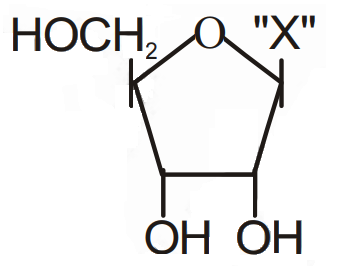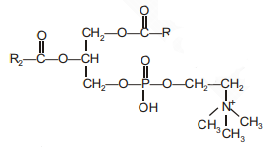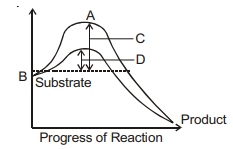A competitive inhibitor like malonate
| 1. | Does affect the Vmax i.e. maximum velocity of the reaction |
| 2. | Gets chemically changed by enzyme action |
| 3. | Increases the apparent Km for a given substrate |
| 4. | Can bind with active site as well as other sites on enzymes |
How many of the given ones belong to single category with respect to type of functional aldehydic group?
Maltose, Lactose, Ribose, Fructose, Inulin
| 1. | Four | 2. | Three |
| 3. | Two | 4. | Five |
Which of the following ones is not the function of steroids?
| 1. | Essential component of animal plasmalemma |
| 2. | To form bile salts |
| 3. | To form channels and pumps |
| 4. | To form vitamin D |
A pair of heterocyclic amino acids is
(1) Phenylalanine and tryptophan
(2) Histidine and arginine
(3) Proline and histidine
(4) Hydroxyproline and tyrosine
The ‘living state’
(1) Can never anyhow be related to metabolism
(2) Is a non-equilibrium state with molecules in a metabolic flux
(3) Is an equilibrium steady-state without any metabolic flux
(4) Is a constant effort to prevent attaining equilibrium without any energy input
At a particular pH and temperature conditions, an inhibitor irreversibly reducing Vmax of a reaction does not
| 1. | Affect the binding of an enzyme for its substrate |
| 2. | Change the Michaelis-Menten constant for that reaction |
| 3. | Compete with the substrate for active site |
| 4. | All of these |
The incorrectly matched column is
|
Macro-molecule |
Monomer |
Function |
Occurrence |
|
|
(1) |
Transfer RNA |
Nucleoside |
Protein synthesis |
Nucleus |
|
(2) |
GLUT-4 |
Amino acid |
Transporter |
Cell membrane |
|
(3) |
Cellulose |
-glucose |
Cell wall synthesis |
Cell wall |
|
(4) |
Carbonic anhydrase |
Amino acid |
Catalysis |
RBCs and plasma |
In sea urchin DNA, which is double stranded 17% of the bases were shown to be cytosine. The percentages of the other three bases expected to be present in this DNA are
| 1. | G 8.5%, A 50%, T 24.5% |
| 2. | G 34%, A 24.5%, T 24.5% |
| 3. | G 17%, A 16.5%, T 32.5% |
| 4. | G 17%, A 33%, T 33% |
Which one of the following is a non - reducing carbohydrate?
| 1. | Maltose | 2. | Sucrose |
| 3. | Lactose | 4. | Ribose 5-phosphate |
The essential chemical components of many coenzymes are:
(1) Nucleic acids
(2) Carbohydrates
(3) Vitamins
(4) Proteins
Transition state structure of the substrate formed during an enzymatic reaction is :
(1) Permanent but unstable
(2) Transient and unstable
(3) Permanent and stable
(4) Transient but stable
Macromolecule chitin is
(1) Phosphorus containing polysaccharide
(2) Sulphur containing polysaccharide
(3) Simple polysaccharide
(4) Nitrogen containing polysaccharide
Which one out of A – D given below correctly represents the structural formula of the basic amino acid?
(1) A
(2) B
(3) C
(4) D
Given below is the diagrammatic representation of one of the categories of small molecular weight organic compounds in the living tissues. Identify the category shown and the one blank component “X” in it
Category Component
(1) Nucleotide Adenine
(2) Nucleoside Uracil
(3) Cholesterol Guanin
(4) Amino acid NH2
Which one of the following biomolecules is correctly characterised?
(1) Alanine amino acid – Contains an amino group and an acidic group anywhere in the molecule
(2) Lecithin – a phosphorylated glyceride found in cell membrane
(3) Palmitic acid – an unsaturated fatty acid with 18 carbon atoms
(4) Adenylic acid – adenosine with a glucose phosphate molecule
The curve given below show enzymatic activity with relation to three conditions (pH, temperature and substrate concentration)
What do the two axes (x and y) represent?
| x-axis | y-axis | |
| 1. | Enzymatic activity | Temperature |
| 2. | Enzymatic activity | pH |
| 3. | Temperature | Enzyme activity |
| 4. | Substrate concentration | Enzymatic activity |
Which one of the following structural formulae of two organic compound is correctly identified along with its related function
A. 
B. 
(1) A : Lecithin – a component of cell membrane
(2) B : Adenine – a nucleotide that makes up nucleic acids
(3) A : Triglyceride – major source of energy
(4) B : Uracil – a component of DNA
The figure given below shows the conversion of a substrate into product by an enzyme. In which one of the four options (1–4) the components of reaction labelled as A, B, C and D are identified correctly?
|
A |
B |
C |
D |
|
|
(1) |
Potential energy |
Transition state |
Activation energy with enzyme |
Activation energy without enzyme |
|
(2) |
Transition state |
Potential energy |
Activation energy without enzyme |
Activation energy with enzyme |
|
(3) |
Activation energy without enzyme |
Transition state |
Activation energy with enzyme |
Potential energy |
|
(4) |
Activation energy with enzyme |
Transition state |
Activation energy without enzyme |
Potential energy |
Three of the following statements about enzymes are correct and one is wrong. Which one is wrong?
| 1. | Enzymes require optimum pH for maximal activity |
| 2. | Enzymes are denatured at high temperature but in certain exceptional organisms they are effective even at temperatures 80°-90°C |
| 3. | Enzymes are highly specific |
| 4. | Most enzymes are proteins but some are lipids |
Carbohydrates are commonly found as starch in plant storage organs. Which of the following five properties of starch (a - e) make it useful as a storage material?
| a. | Easily translocated |
| b. | Chemical non-reactive |
| c. | Easily digested by animals |
| d. | Osmotically inactive |
| e. | Synthesized during photosynthesis |
1. Both a & e
2. Both b & c
3. Both b & d
4. a, c & e
Which of the following is the simplest amino acid?
(1) Tyrosine
(2) Asparagine
(3) Glycine
(4) Alanine
Which of the following statements regarding enzyme inhibition is correct ?
(1) Non-competitive inhibition of an enzyme can be overcome by adding large amount of substrate
(2) Competitive inhibition is seen when a substrate competes with an enzyme for binding to an inhibitor protein
(3) Competitive inhibition is seen when the substrate and the inhibitor compete
(4) Non-competitive inhibitors often bind to the enzyme irreversibly
The catalytic efficiency of two different enzymes can be compared by the
(1) The Km value
(2) The pH optimum value
(3) Formation of the product
(4) Molecular size of the enzyme
Essential amino acid is
(1) Phenylalanine
(2) Glycine
(3) Aspartic acid
(4) Serine
The major role of minor elements inside living organisms is to act as
| 1. | Co-factors of enzymes |
| 2. | Building blocks of important amino acids |
| 3. | Constituents of hormones |
| 4. | Binders of cell structure |
Which are the most diverse molecules in the cell?
(1) Lipids
(2) Mineral salts
(3) Proteins
(4) Carbohydrates
Agar is commercially obtained from
| 1. | Red algae | 2. | Blue-green algae |
| 3. | Brown algae | 4. | Green algae |
1-4 linkages are present in
| 1. | Cellulose | 2. | Chitin |
| 3. | Starch | 4. | Both (1) & (2) |
Which of the following is true for competitive enzyme inhibition?
(1) Decrease in Vmax and Km
(2) Unchanged Vmax and decrease in Km
(3) Unchanged Vmax and increase in Km
(4) Increase in Vmax and Km
Prosthetic group is a part of holoenzyme. It is
| 1. | Loosely attached organic part |
| 2. | Loosely attached inorganic part |
| 3. | Non-protein organic part firmly attached with apoenzyme |
| 4. | None of these |